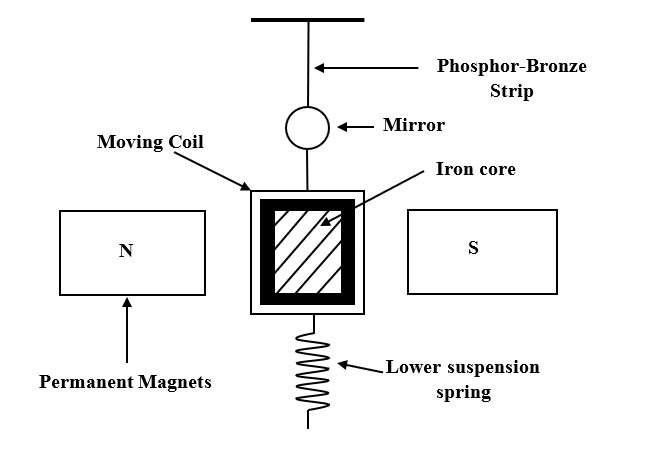
Write the definition of figure of merit of Galvanometer.
Answer
554.1k+ views
Hint: The figure of merit in general is defined as the numerical value representing the degree of effectiveness or efficiency of an instrument approximated by different estimation techniques. Galvanometer is a device which is used to measure small electric current. When current passes through the coil of the galvanometer, a deflection is observed. Use this information to find the definition of figure of merit of Galvanometer.
Complete answer:

Galvanometer is a device used to detect feeble electric voltage and current in a circuit. The figure of merit of a galvanometer can be defined as a current required to produce unit deflection in the galvanometer scale. The figure of merit is denoted by the symbol k. It is given by,
$k= \dfrac {I}{\theta}$ …(1)
Where, I is the current through the coil
$\theta$ is the angle of deflection
At equilibrium,
$I= \left(\dfrac {K}{NAB}\right)\theta$ …(2)
Where, K is the restoring torque per unit twist of spring constant
N is the number of turns in the coil
A is the area of the galvanometer coil
B is the magnetic flux density of the radial magnetic field of galvanometer magnet
Substituting equation. (2) in equation. (1) we get,
$k= \dfrac {\left(\dfrac {K}{NAB}\right)\theta }{\theta}$
$\Rightarrow k= \dfrac {K}{NAB}$ …(3)
But, $G= \dfrac {k}{NAB}$ ...(4)
Where, G is the galvanometer constant
From the equation. (2) and (3) we get,
$k=G$
Note:
Galvanometer has a moderate resistance of about $100 \Omega$ and the galvanometer itself has a small current carrying capacity of 1 mA. The deflection in the galvanometer is directly proportional to the current passed through it. Students must remember that a galvanometer can be used as an ammeter as well as a voltmeter. If we want to use it as an ammeter then it should be connected along the element. Whereas if we have to use a galvanometer as a voltmeter then it should be connected across the element.
Complete answer:

Galvanometer is a device used to detect feeble electric voltage and current in a circuit. The figure of merit of a galvanometer can be defined as a current required to produce unit deflection in the galvanometer scale. The figure of merit is denoted by the symbol k. It is given by,
$k= \dfrac {I}{\theta}$ …(1)
Where, I is the current through the coil
$\theta$ is the angle of deflection
At equilibrium,
$I= \left(\dfrac {K}{NAB}\right)\theta$ …(2)
Where, K is the restoring torque per unit twist of spring constant
N is the number of turns in the coil
A is the area of the galvanometer coil
B is the magnetic flux density of the radial magnetic field of galvanometer magnet
Substituting equation. (2) in equation. (1) we get,
$k= \dfrac {\left(\dfrac {K}{NAB}\right)\theta }{\theta}$
$\Rightarrow k= \dfrac {K}{NAB}$ …(3)
But, $G= \dfrac {k}{NAB}$ ...(4)
Where, G is the galvanometer constant
From the equation. (2) and (3) we get,
$k=G$
Note:
Galvanometer has a moderate resistance of about $100 \Omega$ and the galvanometer itself has a small current carrying capacity of 1 mA. The deflection in the galvanometer is directly proportional to the current passed through it. Students must remember that a galvanometer can be used as an ammeter as well as a voltmeter. If we want to use it as an ammeter then it should be connected along the element. Whereas if we have to use a galvanometer as a voltmeter then it should be connected across the element.
Recently Updated Pages
Master Class 11 Business Studies: Engaging Questions & Answers for Success

Master Class 11 Computer Science: Engaging Questions & Answers for Success

Master Class 11 Maths: Engaging Questions & Answers for Success

Master Class 11 Chemistry: Engaging Questions & Answers for Success

Master Class 11 Economics: Engaging Questions & Answers for Success

Master Class 11 Accountancy: Engaging Questions & Answers for Success

Trending doubts
What is meant by exothermic and endothermic reactions class 11 chemistry CBSE

10 examples of friction in our daily life

One Metric ton is equal to kg A 10000 B 1000 C 100 class 11 physics CBSE

1 Quintal is equal to a 110 kg b 10 kg c 100kg d 1000 class 11 physics CBSE

Difference Between Prokaryotic Cells and Eukaryotic Cells

What are Quantum numbers Explain the quantum number class 11 chemistry CBSE




